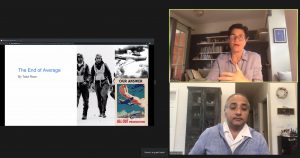Designing for average doesn’t get you great innovation. -@EliseRoy, UX Accessibility & Inclusion Lead at Google
Do you enjoy listening to audiobooks? Use text messaging? Email? Many of us with varied abilities do use these technologies, but did you know these are examples of innovation influenced by or designed for the extreme user and not the average user.
“We are different. And difference is the new normal we should be designing for.” Says Elise and Sanjay Batra, Ph.D. Hardware Research Manager- Pixel, Nest and Inclusive Hardware at Google. Elise and Sanjay spoke about their passion and experience in inclusive design on September 16, 2020 in an event sponsored by the Human Factors and Ergonomics Society.
Presented in Zoom with Closed Captions, Elise and Sanjay present the case that some of our most popular innovations have been born out of the need to design for users who have different abilities. If we are to continue to innovate in the future, we must focus design research specific to users with disabilities. Different from Universal Design which seeks to make a single design fit the most users, designing for the extremes is really about challenging us to get a deep understanding of how people with disabilities experience the world. Designing from that standpoint, says Elise, leads to unprecedented innovation, and of course, extraordinary results.

Not sure how to incorporate more varied users into your design? We’re here to help! [email protected]
A guide for how to enable/use Closed Caption functions in Zoom can be found HERE
Elise offers some additional resources for Ergonomics/Human Factors/UX practitioners here:
Kat Holmes book Mismatch
Google’s Pixel Camera is a great example of inclusion
Jutta Trevarinu’s work at the Inclusive Design Research Centre
University of Cambridge Inclusive Design Toolkit
#exponentehf #ergonomics #humanfactors #disability #design


Leave A Comment